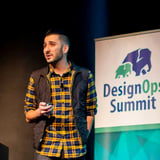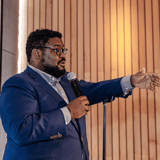Summary
Kara, a design leader at MasterCard, discusses the company’s digital transformation journey emphasizing design as a core business differentiator. She explains how MasterCard is evolving from traditional plastic card payments to device-based commerce integrating biometrics, IoT, and secure tokenization. Kara highlights innovations such as payment-enabled wearables, connected home appliances, and robot-based payment pilots. She stresses that delivering great employee and user experiences in a complex enterprise environment requires strong cross-functional relationships, authentic engagement with the design community, and alignment of leadership around a clear agenda. Kara also shares practical insights on hiring thoughtfully to build intellectually curious teams aligned with company values, and redefines performance management as an essential part of the employee experience involving continuous coaching and transparent development conversations. She advocates earning the 'seat at the table' through driving impactful business outcomes and fostering customer empathy across all organizational partners. Her talk offers a grounded, tactical perspective on leading design and talent in large, matrixed organizations amid rapid digital change.
Key Insights
-
•
MasterCard is actively transitioning from plastic cards to device-based commerce, embedding payments in wearables, IoT devices, and apps.
-
•
Biometric authentication, such as selfie pay with proof of life, is becoming a key method to securely authenticate consumers during transactions.
-
•
Building cross-functional relationships beyond immediate teams, including with finance, sales, and technology peers, is critical for enterprise design leadership.
-
•
Employee experience and performance management should center on continuous coaching and transparent communication to avoid surprises in reviews.
-
•
Hiring based on alignment with company values and intellectual curiosity leads to better engagement and retention in competitive markets.
-
•
Design leaders must develop an actionable agenda, actively solicit feedback from executives, and frequently communicate progress to build credibility.
-
•
Customer empathy can be increased by involving non-design functions like legal, compliance, and security in usability testing.
-
•
Successful innovation at MasterCard includes pilot projects integrating payments into unexpected devices like robots and smart home appliances.
-
•
Legacy enterprise complexity requires leaders to negotiate ambiguity and incremental delivery with minimum viable products evolving over time.
-
•
Aligning leadership and sponsors to your mission often demands strong negotiation and influence skills to drive consensus in large matrix organizations.
Notable Quotes
"If you have somebody on your team for three years, for five years, that’s amazing from a longevity perspective given enterprise legacy and complexity."
"Consumers are clamoring for payment to be embedded in their devices because payment can be a pain point in digital commerce."
"With selfie pay, you take a picture, blink to prove it’s you alive, and authenticate in-app seamlessly and securely."
"How many people here actually know how their company makes money? 100% should understand this to lead effectively."
"If your leadership isn’t aligned to your agenda, it’s vital to negotiate and influence to bring them on board."
"You earn your seat at the table by championing excellent customer experience and rallying the project team behind it."
"Don’t send your recruiters to spam LinkedIn. That damages your brand and turns off potential candidates."
"Most employees take at least 90 days to onboard and another 90 days to become productive — that’s half a year before you see impact."
"Performance management is really about the employee experience; avoid surprises by coaching continuously on both what and how folks are doing."
"If there’s a performance gap, don’t sit on it; it doesn’t age well and hurts the team, employee, and business."
Or choose a question:
















More Videos

"After the move, our work had more impact, more visibility, and we're present across the entire product life cycle."
Nalini KotamrajuResearch After UX
March 25, 2024

"Society grows great when old people plant trees they know they shall never sit in."
Dean BroadleyNot Black Enough to be White
January 8, 2024

"Every day is a chance to check: is this how I want to be? This is a long-haul, marathon effort."
Denise Jacobs Nancy Douyon Renee Reid Lisa WelchmanInteractive Keynote: Social Change by Design
January 8, 2024

"Design thinking helped us empathize, define problems, co-create ideas, and then test them like products."
Kim Fellman CohenMeasuring the Designer Experience
October 23, 2019

"Why do designers decide how to design this? How do we wean design's addiction from whiteness?"
George AyeThat Quiet Little Voice: When Design and Ethics Collide
November 16, 2022

"You need to be the connector between people trying to drive decisions and others influencing them."
Nathan CurtisBeyond the Toolkit: Spreading a System Across People & Products
June 9, 2016

"There is an enormous amount of diversity in the real estate agent community, from demographics to technology savvy to regional differences."
Greg PetroffThe Compass Mission
March 10, 2021

"Digital connectivity is necessary for participation in society, but half the world lacks internet access."
Chloe Amos-EdkinsA Cultural Approach: Research in the Context of Glocalisation
March 27, 2023

"We are not collecting vanity analytics, the data is doing real work on informing design."
Mackenzie Cockram Sara Branco Cunha Ian FranklinIntegrating Qualitative and Quantitative Research from Discovery to Live
December 16, 2022
















